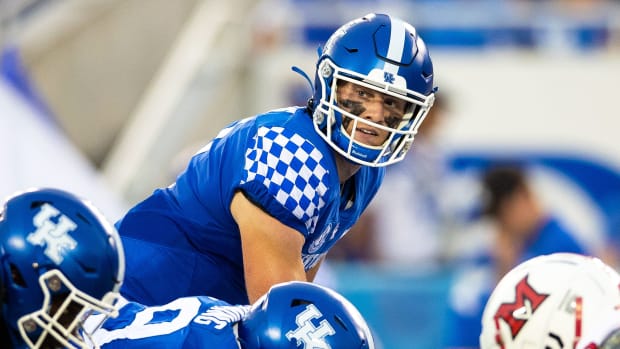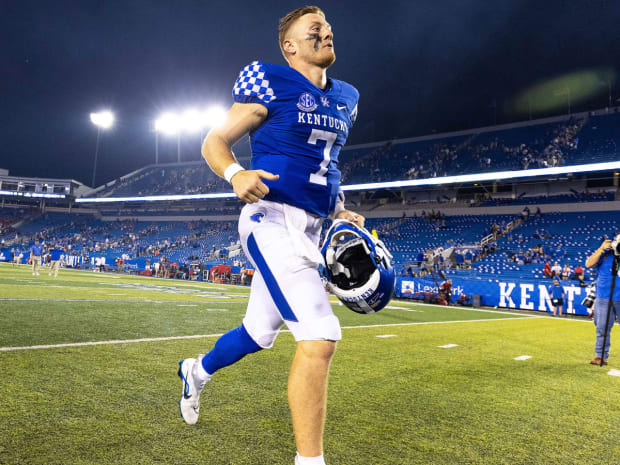If you’ve been paying attention over the last year, you may be surprised by a name that has crept up some way-too-early 2023 NFL draft boards: Kentucky quarterback Will Levis.
He doesn’t have the production of QB class peers C.J. Stroud or Bryce Young, but the hype grew anyway over the offseason. To find the main source of that hype, you have to first go back to Kentucky’s pro day in March, where draft-eligible former Wildcats worked out for NFL scouts in preparation for the 2022 draft. Thanks to a rule change that allowed undeclared players to work out for scouts as well (Young and Stroud did the same thing at their school’s pro days), Levis was put through a last-minute throwing session with a teammate.
“I was talking to [new offensive coordinator Rich Scangarello], and he was like, ‘I know what these guys want to see, and I’m gonna put together a script of 16 types of throws that they’re looking for, and we’re gonna have [DeMarcus Harris] out there catching for you, and it’s gonna be great.’ I threw the ball well, spun it, and it was cool to be in that environment and have all those eyes on you. I felt comfortable out there and that was cool.”

Jordan Prather/USA TODAY Sports
One NFL scout told Sports Illustrated he hadn’t watched Levis much at all before that point, but turned the tape on this offseason after being told by another scout how Levis looked at the pro day. But there’s more than just the workout to consider when you think about the way Kentucky is trying to pivot its program.
Kentucky may not be the first team you think of when listing college football’s most intriguing offensive shifts, but it is trying to build upon something that’s all the rage at the NFL level. “Pro-style offense” has had different definitions over the years, but at present it’s a ground game that is predicated on an outside-zone run scheme using bootlegs and play-action to set up a vertical passing game—which Kentucky hasn’t had much of over the last few seasons.
Zone-blocking in college football is far from a foreign concept. It’s the partial namesake of the trend that dominated the sport over the past decade: the zone read. Offensive linemen have an area of the defensive front they’re responsible for, and they block who is in their zone. If they’re “uncovered,” they double-team with the lineman next to them and look to get to the second level to take on a linebacker. In the late 1990s, Denver Broncos coach Mike Shanahan and his offensive line coach Alex Gibbs popularized the blocking scheme. It has been the foundation that allowed quarterbacks who are not exactly all-pros—such as the Lions’ Jared Goff and the Titans’ Ryan Tannehill—to have deep playoff runs thanks to the play-action passing attacks you can build on top of a stable rushing foundation.
The NFL coaches currently at the forefront of continuing the trend are Shanahan’s son, Kyle, in San Francisco and Rams coach Sean McVay. (Both worked for Mike in Washington.) But roughly 25% of NFL offenses are connected to the Shanahan coaching tree, with that number likely to grow over the next few years. Which brings us back to Kentucky.
Liam Coen was brought to Lexington as offensive coordinator and quarterbacks coach heading into the 2021 season to develop Levis and start to implement this brand of offense. In the run game, the Cats dabbled in the outside zone in ’21 but didn’t major in it due to their personnel, opting to run much more between the tackles then outside of them. Previously, Coen spent three seasons on McVay’s staff in Los Angeles as assistant receivers coach and then as assistant quarterbacks coach. He’s since returned to the Rams to be their offensive coordinator, but the pro-style game he began building will continue under Scangarello, who comes from San Francisco (where he was the 49ers’ quarterbacks coach) and brings offensive line coach Zach Yenser with him.
“I was one of the first people to know that Liam was leaving,” Levis says. “We sat down with coach Coen and coach Stoops for a few hours to kinda talk about it. And from that moment on [Stoops] made it very clear to me that I was gonna be a huge part of the process in choosing a new offensive coordinator. I was there for the interviews for all the coaches that we talked to, which was awesome. We had some really good candidates. Once we interviewed coach Scangs, right away we knew that this was the guy. We kinda felt lucky that he fell into our lap. But for coach [Stoops] to involve me in that process was really special.”
Stoops says he took basically no input on hiring Coen, but this time was different. In more ways than just what’s on the field, Kentucky’s taken a pro-style approach. Veteran quarterbacks in the pros can certainly be consulted on who they want to pair with in the coordinator-QB tandem. A similar process played out in Lexington.
“With this one I think it was important for a guy like Will, because personality is important,” Stoops says. “Liam had an infectious personality but he also was extremely knowledgeable and the system fit us. I wanted Will to sit in and just listen and just give me his input as we talked about it. I thought it was really important. I believe he’s a franchise quarterback in the NFL. He’s certainly our franchise quarterback at Kentucky right now.”
If Scangarello (the fifth offensive coordinator Levis has played with in his college career between Penn State and Kentucky) can get Levis to succeed in this system, it will be an advertisement for the program that it can develop quarterbacks for the next level. For Levis, he’d get to head into the NFL with two years’ experience in a popular offensive system.

Jordan Prather/USA TODAY Sports
Levis passes the eye test on measurables: He’s 6'3" and has plenty of arm strength—he finished fifth in total passing yards, sixth in passing touchdowns and second in rushing TDs in the SEC in 2021. He has shown flashes of brilliance in carrying out the Rams’ passing concepts Coen implemented, but he has a propensity to turn the ball over (13 interceptions last year) and he needs to clean up his overall footwork and accuracy. He’ll also likely be asked to handle more in pass protection with veteran center Luke Fortner now in the NFL. Stoops has acknowledged that’s an area Kentucky has to improve on, as late last season Levis was getting hit more than they’d like.
Most early 2023 mock drafts have Levis going in the first round, but he is certainly not a finished product as a passer. A bet on him now is a bet on the traits he has—as one personnel evaluator told SI, “he has NFL tools right now, not NFL tape.”
Watch college football live with fuboTV: Start your free trial today!
Levis will be counting on a combination of young receivers to replace Wan’Dale Robinson, the target on 40% of the QB’s throws last year: Harris, who has the most career receptions (26) of returning players, Lexington-native freshman Dane Key, and transfer Tayvion Robinson. Robinson in particular shined in the season opener, with six catches on a team-high eight targets for 136 yards. But the Cats will have to iron out issues with drops.
In front of Levis, pass protection issues hindered Kentucky in its season-opening win against Miami (Ohio). Levis was sacked four times, three of which came on third downs. Stoops says the coaching staff has “a good idea” of where those issues come from, but they’ll need to be improved quickly before a Week 2 tilt against Florida. Kentucky used five first-time starters in the opener, and its Week 2 depth chart shows that there will be changes again as that new unit tries to gel. The early season O-line issues and receiver issues play into another thing Kentucky will have to improve on: explosive vertical passes, which it lacked against the RedHawks as well.
Yenser has said he is trying to develop an eight-man O-line rotation, so depth will be the concern beyond just making sure the starters are capable. They will potentially pave the way for one of the conference’s top running backs, Chris Rodriguez Jr., who ran for 1,379 yards last year. Rodriguez, however, pleaded guilty to a DUI charge in July and is serving a suspension from which his return remains unclear. On the whole, the Wildcats’ RB depth behind Kavosiey Smoke is extremely thin.
Despite all of the pieces moving around him, Levis in Week 1 did show some of the things that have him on the radar of NFL decision-makers—including the way he reads out concepts and uses his arm strength to come back to throws over the middle of the field and hit them with accuracy. If he can continue to showcase command over this offense at this level, he’ll be given charge of one at the next level soon.







